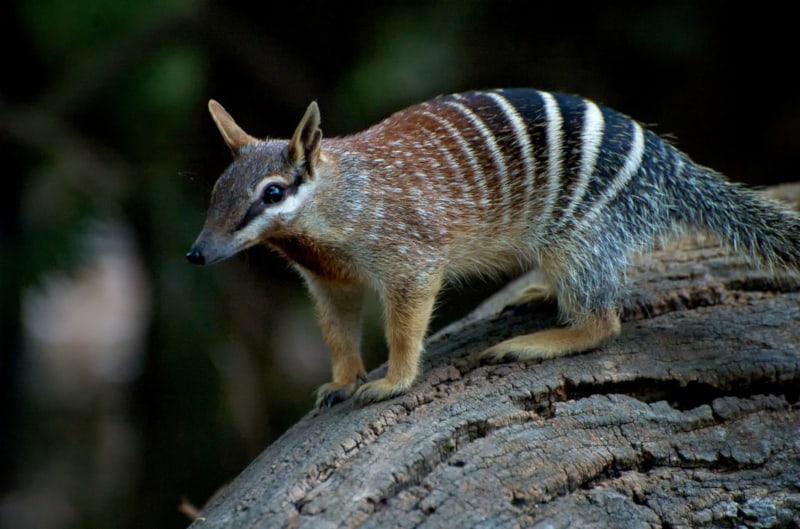
Numbat Facts
- The truly amazing Numbat remains perhaps one of the least known of all marsupials. The remarkable creature also goes by the other common names of the walpurti or the noombat. This fascinating animal further bears the somewhat cumbersome scientific name of Myrmecobius fasciatus.
- However, regardless of the name one calls it by, it represents a most unusual animal in several ways. First of all, it represents one of the few known marsupials to have an entirely insectivorous diet. The great majority of its related species feed as either herbivores, carnivores, or omnivores.
- Secondly, this incredible mammal distinguishes itself from similar species in yet another manner. In this instance, this occurs in regards to its pattern of activity. That’s because the marvelous Numbat remains the only known marsupial in the world to have a completely diurnal pattern of behavior.
- This surprising animal first became known to Europeans in 1831. At that time, it inhabited a comparatively broad natural range. Unfortunately, however, that no longer remains the case. It currently only inhabits a highly restricted and limited range, constituting only a fraction of its previous territory.
- Quite fortunately, its remaining native habitat range encompasses two protected locations. This offers the surviving individuals a measure of protection. In addition, a few individuals have also been reintroduced into a few small reserves. Due to these factors, the IUCN currently list the animal as Endangered.
Related Articles
Numbat Physical Description
While the awesome Numbat certainly is amazing, the fascinating animal does not earn this consideration due to its physical size. That’s because the mammal actually ranks as a comparatively small variety of marsupial. It also displays a moderate degree of sexual dimorphism. In its case, this presents itself in the fact that females attain a slightly smaller average weight than the males of the astounding species.
However, despite the difference in weights, both genders of the Numbat attain roughly the same body length. That remains true due to the fact that both sexes reach a maximum body length of about 11.4 in (29 cm). Further, the tail adds an average of 6.5 in (16.5 cm). Yet the males of this species typically weigh roughly 1.3 lb (0.59 kg). But, exceptional males may weigh up to 1.66 lb (0.75 kg). Meanwhile, females average 1.05 lb (0.48 kg), with exceptional individuals weighing as much as 1.49 lb (0. 68 kg).
Yet, the colors vary significantly between individuals of both genders. These range from reddish-brown to a soft gray color. In addition, a region of dark red appears of the upper back. An obvious black stripe also extends from the sharply pointed muzzle to the base of the ears. Oddly, a series of white stripes also cross its hindquarters. These range in number from 4 – 11, depending on the individual. The underbelly of the animal displays either a light gray or a cream color. The tail has a covering of long grayish-white fur.
- Kingdom: Animalia
- Phylum: Chordata
- Class: Mammalia
- Order: Dasyuromorphia
- Family: Myrmecobiidae
- Genus: Myrmecobius
- Species: M. fasciatus
Numbat Distribution, Habitat, and Ecology
Perhaps most notably, the wonderful Numbat, quite sadly, now inhabits only a fraction of its original native range. Prior to European discovery and habitation of the continent, it thrived throughout much of Australia. Now, however, its territory consists solely of two protected areas in the western regions, and several preserves. These latter locations remain quite widely scattered through the west and south parts of the continent, as well as one located in New South Wales.
Prior to the human-caused reduction of its range, the remarkable Numbat lived mainly in regions of grasslands and both arid and semi-arid woodlands. Now, however, it only lives in areas of eucalyptus woodlands. Further, even there it inhabits an extremely specific altitude range. This holds true due to its presence being restricted to protected areas. These all have an altitude measuring roughly 1,040 ft (317 m). This further consists of extremely moist forest regions.
Since it remains solely active during the day, the Numbat typically spends its night in yet another highly specific location. This consists of fallen hollow logs. Herein, the animal studiously avoids the majority of its natural predators, mainly consisting of foxes and large birds. It itself, in an unusual trait among its related species, feeds exclusively on termites. This further restricts its habitat range to locations with a large presence of this insect, since each individual consumes an average of 20,000 termites per day.
Species Sharing Its Range
Check out our other articles on 5 Incredible South American Islands, Chilean Dolphin, Lake Titicaca, Bismarck Palm, Achrioptera manga, Olive Ridley Sea Turtle, Purple Frog, Walrus
